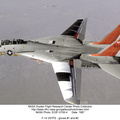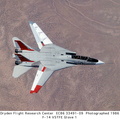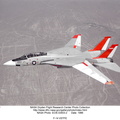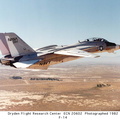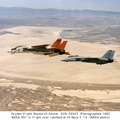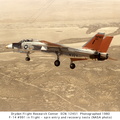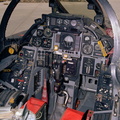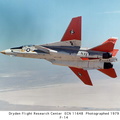
WIKIARCHIVES.SPACE
The Human Spaceflight Archive

NASA 991, an F-14 Navy Tomcat designated the F-14 (1X), cruises over the desert on a research flight at NASA's Dryden Flight Research Center, Edwards, California. The F-14 was used at Dryden between 1979 and 1985 in extensive high-angle-of-attack and spin-control-and-recovery tests.
Information
- Taken in
- Edwards Air Force Base
- Tác giả
- NASA
- Miêu tả
-
NASA 991, an F-14 Navy Tomcat designated the F-14 (1X), cruises over the desert on a research flight at NASA's Dryden Flight Research Center, Edwards, California. The F-14 was used at Dryden between 1979 and 1985 in extensive high-angle-of-attack and spin-control-and-recovery tests.
The NASA/Navy program, which included 212 total flights, achieved considerable improvement in the F-14 high-angle-of-attack flying qualities, improved departure and spin resistance, and contributed to substantial improvements in reducing "wing rock," (i.e., tilting from one side to another), at high angles of attack.
NASA 991 had numerous special additions for high-angle-of-attack and spin-recovery research. These included a battery-powered auxiliary power unit, a flight test nose boom, and a special spin recovery system, consisting of forward mounted, hydraulically actuated canards and an emergency spin chute.
NASA's F-14 was first flown by NASA research pilots, but was later flown by Grumman, and by Navy test pilots from Patuxent River Naval Air Station (NAS). The Navy test flights with the spin research vehicle constituted the first program that incorporated air combat maneuvering in its test flights at Dryden. The Navy brought F-14s from Point Mugu and Miramar NAS in San Diego to test the new spin control laws in combat situations. Although the new control laws proved valuable, the Navy did not incorporate them into production F-14s until the F-14D, nearly 15 years later.
Among the 212 flights completed for this research project, the F-14 also tested a flush air data system, for gathering data about air speed; provided an updated aeromodel, which is currently in use on Navy F-14 training simulators; created natural laminar flow baseline data for many of NASA's later laminar flow programs; and tested low altitude, asymetric thrust.
- Khởi tạo vào
- Chủ Nhật 12 Tháng Chín 1982
- Đề mục
- US SPACE PROGRAM / AERONAUTICS RESEARCH / F-14 TOMCAT
- Source link
- https://www.dfrc.nasa.gov/Gallery/Photo/F-14/index.html
- Thăm quan
- 14
- Bảng xếp hạng
- không có đánh giá
- Đánh giá hình này
- License
- Public Domain
- Modified by WikiArchives
- No (original)
- Tải xuống
- 0
Sản phẩm của Piwigo
